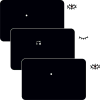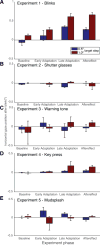Target Displacements during Eye Blinks Trigger Automatic Recalibration of Gaze Direction
- PMID: 28111150
- PMCID: PMC5308877
- DOI: 10.1016/j.cub.2016.12.029
Target Displacements during Eye Blinks Trigger Automatic Recalibration of Gaze Direction
Abstract
Eye blinks cause disruptions to visual input and are accompanied by rotations of the eyeball [1]. Like every motor action, these eye movements are subject to noise and introduce instabilities in gaze direction across blinks [2]. Accumulating errors across repeated blinks would be debilitating for visual performance. Here, we show that the oculomotor system constantly recalibrates gaze direction during blinks to counteract gaze instability. Observers were instructed to fixate a visual target while gaze direction was recorded and blinks were detected in real time. With every spontaneous blink-while eyelids were closed-the target was displaced laterally by 0.5° (or 1.0°). Most observers reported being unaware of displacements during blinks. After adapting for ∼35 blinks, gaze positions after blinks showed significant biases toward the new target position. Automatic eye movements accompanied each blink, and an aftereffect persisted for a few blinks after target displacements were eliminated. No adaptive gaze shift occurred when blinks were simulated with shutter glasses at random time points or actively triggered by observers, or when target displacements were masked by a distracting stimulus. Visual signals during blinks are suppressed by inhibitory mechanisms [3-6], so that small changes across blinks are generally not noticed [7, 8]. Additionally, target displacements during blinks can trigger automatic gaze recalibration, similar to the well-known saccadic adaptation effect [9-11]. This novel mechanism might be specific to the maintenance of gaze direction across blinks or might depend on a more general oculomotor recalibration mechanism adapting gaze position during intrinsically generated disruptions to visual input.
Keywords: adaptation; eye blinks; eye movements; oculomotor system; recalibration; suppression of displacement; visual stability.
Copyright © 2017 Elsevier Ltd. All rights reserved.
Figures



Similar articles
-
The perceptual consequences and neurophysiology of eye blinks.Front Syst Neurosci. 2023 Aug 16;17:1242654. doi: 10.3389/fnsys.2023.1242654. eCollection 2023. Front Syst Neurosci. 2023. PMID: 37654528 Free PMC article. Review.
-
Directional biases for blink adaptation in voluntary and reflexive eye blinks.J Vis. 2019 Mar 1;19(3):13. doi: 10.1167/19.3.13. J Vis. 2019. PMID: 30921815 Clinical Trial.
-
Blink-perturbed saccades in monkey. I. Behavioral analysis.J Neurophysiol. 2000 Jun;83(6):3411-29. doi: 10.1152/jn.2000.83.6.3411. J Neurophysiol. 2000. PMID: 10848559
-
Properties of horizontal saccades accompanied by blinks.J Neurophysiol. 1998 Jun;79(6):2895-902. doi: 10.1152/jn.1998.79.6.2895. J Neurophysiol. 1998. PMID: 9636095 Clinical Trial.
-
How the eyes respond to sounds.Ann N Y Acad Sci. 2024 Feb;1532(1):18-36. doi: 10.1111/nyas.15093. Epub 2023 Dec 28. Ann N Y Acad Sci. 2024. PMID: 38152040 Review.
Cited by
-
Signals driving the adaptation of saccades that require spatial updating.J Neurophysiol. 2018 Aug 1;120(2):525-538. doi: 10.1152/jn.00075.2018. Epub 2018 Apr 25. J Neurophysiol. 2018. PMID: 29694278 Free PMC article.
-
The perceptual consequences and neurophysiology of eye blinks.Front Syst Neurosci. 2023 Aug 16;17:1242654. doi: 10.3389/fnsys.2023.1242654. eCollection 2023. Front Syst Neurosci. 2023. PMID: 37654528 Free PMC article. Review.
-
Real-Time MRI Reveals Unique Insight into the Full Kinematics of Eye Movements.eNeuro. 2022 Jan 7;9(1):ENEURO.0357-21.2021. doi: 10.1523/ENEURO.0357-21.2021. Print 2022 Jan-Feb. eNeuro. 2022. PMID: 34876474 Free PMC article.
-
Eyeball translations affect saccadic eye movements beyond brainstem control.J Neurophysiol. 2023 Nov 1;130(5):1334-1343. doi: 10.1152/jn.00021.2023. Epub 2023 Oct 25. J Neurophysiol. 2023. PMID: 37877201 Free PMC article.
-
The Role of Blinks, Microsaccades and their Retinal Consequences in Bistable Motion Perception.Front Psychol. 2021 Apr 8;12:647256. doi: 10.3389/fpsyg.2021.647256. eCollection 2021. Front Psychol. 2021. PMID: 33897552 Free PMC article.
References
-
- Riggs LA, Kelly JP, Manning KA, Moore RK. Blink-related eye movements. Invest Ophthalmol Vis Sci. 1987;28:334–42. - PubMed
-
- Volkmann FC, Riggs L, Moore R. Eyeblinks and visual suppression. Science. 1980;207:900–2. - PubMed
-
- Riggs LA, Volkmann FC, Moore RK. Suppression of the blackout due to blinks. Vision Res. 1981;21:1075–9. - PubMed
-
- Manning KA, Riggs LA, Komenda JK. Reflex eyeblinks and visual suppression. Percept Psychophys. 1983;34:250–6. - PubMed
MeSH terms
Grants and funding
LinkOut - more resources
Full Text Sources
Other Literature Sources

